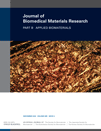Bioactive bone cement with a low content of titania particles without postsilanization: Effect of filler content on osteoconductivity, mechanical properties, and handling characteristics
Abstract
In this study, we developed three types of polymethylmethacrylate (PMMA)-based composite cement with low contents of nonsilanized titania particles (5, 10, and 20 wt % TiO2, respectively: designated T5, T10, and T20). The osteoconductivity, mechanical properties, and handling characteristics of these cements were compared with those of commercially available PMMA cement (PMMAc). The cement was inserted into rat tibiae and solidified in situ. After 6 and 12 weeks, tibiae were removed for evaluation of osteoconductivity using Stevenel's Blue and Van Gieson's picrofuchsin staining. The affinity indices reflecting the osteoconductivity of T10 and T20 were 33.4 ± 12.8 and 56.5 ± 14.1 at 6 weeks, and 67.0 ± 18.0 and 65.0 ± 51.7 at 12 weeks, respectively, and were significantly higher than for PMMAc (p < 0.01). The compressive and flexural strengths of T5, T10, and T20 exceeded those of PMMAc, whereas the elasticity did not differ significantly. Scanning electron microscopy and energy-dispersive X-ray microanalysis showed that the micron-sized and spherical titania particles were well dispersed in T20 and were exposed on the surface of the cement that made direct contact with bone. These results show that T20 is a promising bioactive bone cement for use in prosthesis fixation. © 2010 Wiley Periodicals, Inc. J Biomed Mater Res Part B: Appl Biomater, 2010.




